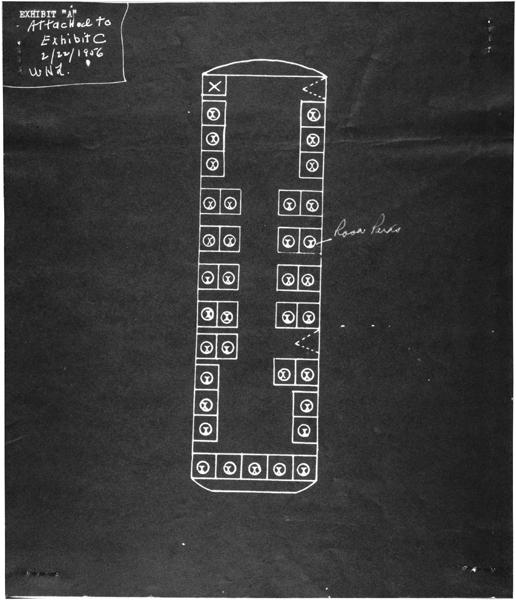Illustration of Where Rosa Parks Sat, December 1, 1955
Below is a diagram of the bus Parks rode with her name connected with a dash pointing to her seat. The diagram was used in the Supreme Court case, Aurelia S. Browder v. William A. Gayle. The 1956, ten month case stemmed from four African American women being mistreated on city buses. The case declared that segregation of public buses unconstitutional. Parks was not included in the case because Browder's lawyer, Fred Gray, did not want people to think that Browder's aids were trying to avoid Parks' prosecution by using Browder's case. Gray also wanted to have one case that would decide the segregation of public buses.
Sources:
Bredhoff, Stacey, Wynell Schamel, and Lee Ann Potter. "The Arrest Records of Rosa Parks." Social Education 63, 4 (May/June 1999): 207-211.
"Browder v Gayle, 352 U.S. 903". Martin Luther King Jr Encyclopedia. Standford University: The Martin Luther King, Jr. Research and Education Institute. https://kinginstitute.stanford.edu/encyclopedia/browder-v-gayle-352-us-903 (Accessed November 9, 2018).

Illustration of bus where Rosa Parks sat, December 1, 1995. Civil Case 1147 Browder, et al v. Gayle, et al; U.S. District Court for Middle District of Alabama, Northern Division Record Group 21: Records of the District Court of the United States National Archives and Records Administration-Southeast Region, East Point, GA. National Archives Identifier 596069. https://www.archives.gov/education/lessons/rosa-parks (Accessed November 9, 2018)
Public Domain
Public Domain is a copyright term that is often used when talking about copyright for creative works. Under U.S. copyright law, individual items that are in the public domain are items that are no longer protected by copyright law. This means that you do not need to request permission to re-use, re-publish or even change a copy of the item. Items enter the public domain under U.S. copyright law for a number of reasons: the original copyright may have expired; the item was created by the U.S. Federal Government or other governmental entity that views the things it creates as in the public domain; the work was never protected by copyright for some other reason related to how it was produced (for example, it was a speech that wasn't written down or recorded); or the work doesn't have enough originality to make it eligible for copyright protection.